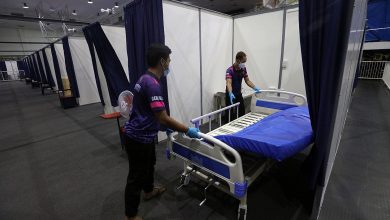Crucial three weeks for DoH

The recent rise in the number of COVID cases is a not-so-gentle reminder that the pandemic is far from over. While it may seem that almost everything is back to the way they were pre-pandemic, the fact of the matter is, COVID-19 continues to put people in hospitals and in graves. Along with the case count, the death count is also on the uptick.
OCTA Research forecasts COVID-19 cases to reach 1,000 per day by the end of this June or early July, noting that Metro Manila might hit the peak in infections in the first two weeks of next month. OCTA’s Guido David told media that those numbers would put the capital at “moderate risk,” up from its present low-risk category.
The Department of Health (DoH) said the country was seeing the start of another peak in COVID-19 cases, with infections almost doubling to a daily average of 436 cases last week from just 240 the previous week. But the healthcare utilization rate has not gone up significantly in the same period. Other than Metro Manila, infections are also on the rise in the Ilocos region, Cagayan Valley, Calabarzon, Mimaropa, Western Visayas, and Northern Mindanao.
More transmissible Omicron subvariants, increased mobility, and waning vaccine immunity are the main drivers of the surge, according to the DoH. The recent rise in the number of cases is the “start of the peak,” said Health Undersecretary Maria Rosario Vergeire, noting the “rapid and sharp increase” in infections. “This might be the start that cases will continuously rise in the next couple of weeks,” she told media.
The next three weeks will thus be crucial for the DoH. Other than what appears to be the start of another COVID surge, it is also within this period that transition will occur. Health Secretary Francisco Duque, along with several other senior Health officials, are expected to step down on June 30 as President-elect Ferdinand Marcos, Jr. and his Cabinet assume office. And this will occur with the DoH not enjoying the benefit of a longer transition.
To date, the President-elect is still to name his Health Secretary. While the Republic will not collapse because of this, public health in general would have been better served by an early transition at the Health department. Mr. Marcos had said he would complete his Cabinet before his inauguration on June 30. Meantime, he has also opted to serve as interim Agriculture Secretary.
“The shortlist is getting shorter, let me put it that way. If we started with 10 names, a dozen names, we are down to maybe three or two in each of those departments,” Mr. Marcos told the media when asked about his picks for other agencies such as the DoH and the Department of Foreign Affairs.
“We took it really department by department, and of course Health, not to say that the DoH is unimportant, but we’re coming around to that,” he added. “I wouldn’t be surprised if we have an appointee or a nominee within the next week or so. I really want to get as many of those done before the inauguration.”
As I wrote previously, by July 1, it will be the Marcos II Administration’s responsibility to keep track of COVID-19 and other pandemics that may affect the country. Sadly, the delay in the nomination or designation of a new Health Secretary also put off the planning of new ways, methods, approaches, and interventions to further improve and future-proof our pandemic management.
As I had noted, the transition period between administrations is a crucial period, more so for a country like the Philippines that is experiencing a public health crisis. And while Mr. Marcos, I am sure, considers the DoH a priority, his delayed action on the matter appears to indicate otherwise. In my opinion, there is real urgency in the appointment of a new Health Secretary.
Too many things will be left hanging by next week, including the existence of ad hoc groups like the National Task Force Against COVID-19 (NTF) and the National Vaccination Operations Center (NVOC). This is a matter of grave concern given that the DoH points to the slow uptake in booster shots as one of the drivers of the present COVID surge.
Up until a new DoH secretary is in place, and the final set of senior Health officials are in office, things will most likely move slowly at the Health department. I doubt very much if the new team can hit the ground running. Everybody will probably wait for direction and personnel changes before pushing any new initiative. Meantime, many things will be on autopilot, or on a holding pattern.
The saving grace is that the bureaucracy remains intact. Work will continue, with or without a new secretary. However, the opportunity was obviously lost to plan ahead had a new secretary been named and given more time to meet with outgoing officials prior to the June 30 handover. COVID is not a thing of the past, and more pandemics — perhaps even worse ones — may still come.
As we have seen previously, the COVID case count can go from bad to worse in just a matter of days. At this point, waiting until the last minute to name a new DoH chief may no longer make a big difference. It is just that I hate to think that as government restarts on July 1, then the same goes for pandemic management. Can we expect positive results from new people rethinking the problem right in the middle of a surge?
Marvin Tort is a former managing editor of BusinessWorld, and a former chairman of the Philippine Press Council




